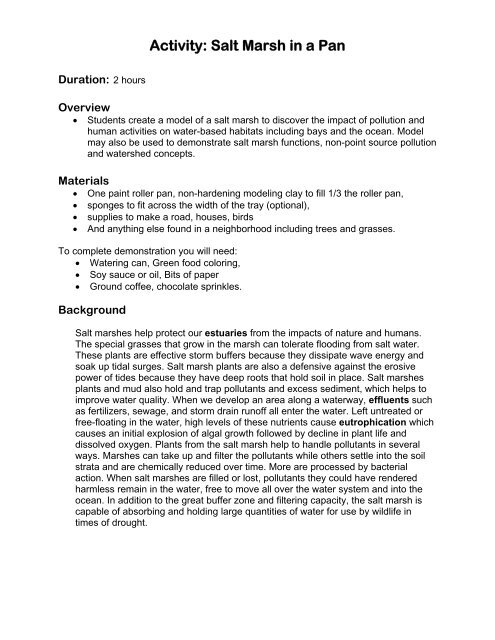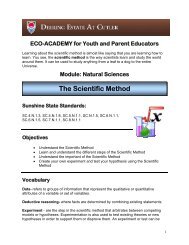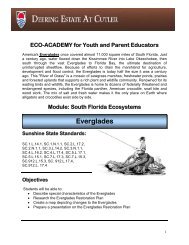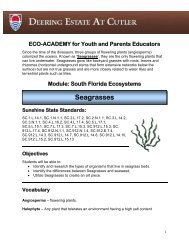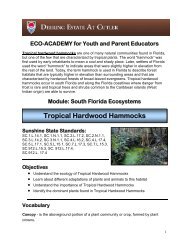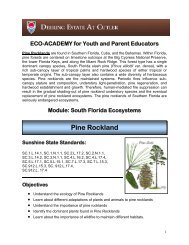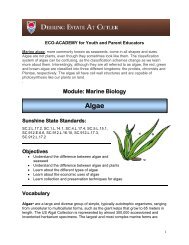Salt Marshes Lesson Plan - Deering Estate at Cutler
Salt Marshes Lesson Plan - Deering Estate at Cutler
Salt Marshes Lesson Plan - Deering Estate at Cutler
You also want an ePaper? Increase the reach of your titles
YUMPU automatically turns print PDFs into web optimized ePapers that Google loves.
Dur<strong>at</strong>ion: 2 hours<br />
Activity: <strong>Salt</strong> Marsh in a Pan<br />
Overview<br />
• Students cre<strong>at</strong>e a model of a salt marsh to discover the impact of pollution and<br />
human activities on w<strong>at</strong>er-based habit<strong>at</strong>s including bays and the ocean. Model<br />
may also be used to demonstr<strong>at</strong>e salt marsh functions, non-point source pollution<br />
and w<strong>at</strong>ershed concepts.<br />
M<strong>at</strong>erials<br />
• One paint roller pan, non-hardening modeling clay to fill 1/3 the roller pan,<br />
• sponges to fit across the width of the tray (optional),<br />
• supplies to make a road, houses, birds<br />
• And anything else found in a neighborhood including trees and grasses.<br />
To complete demonstr<strong>at</strong>ion you will need:<br />
• W<strong>at</strong>ering can, Green food coloring,<br />
• Soy sauce or oil, Bits of paper<br />
• Ground coffee, chocol<strong>at</strong>e sprinkles.<br />
Background<br />
<strong>Salt</strong> marshes help protect our estuaries from the impacts of n<strong>at</strong>ure and humans.<br />
The special grasses th<strong>at</strong> grow in the marsh can toler<strong>at</strong>e flooding from salt w<strong>at</strong>er.<br />
These plants are effective storm buffers because they dissip<strong>at</strong>e wave energy and<br />
soak up tidal surges. <strong>Salt</strong> marsh plants are also a defensive against the erosive<br />
power of tides because they have deep roots th<strong>at</strong> hold soil in place. <strong>Salt</strong> marshes<br />
plants and mud also hold and trap pollutants and excess sediment, which helps to<br />
improve w<strong>at</strong>er quality. When we develop an area along a w<strong>at</strong>erway, effluents such<br />
as fertilizers, sewage, and storm drain runoff all enter the w<strong>at</strong>er. Left untre<strong>at</strong>ed or<br />
free-flo<strong>at</strong>ing in the w<strong>at</strong>er, high levels of these nutrients cause eutrophic<strong>at</strong>ion which<br />
causes an initial explosion of algal growth followed by decline in plant life and<br />
dissolved oxygen. <strong>Plan</strong>ts from the salt marsh help to handle pollutants in several<br />
ways. <strong>Marshes</strong> can take up and filter the pollutants while others settle into the soil<br />
str<strong>at</strong>a and are chemically reduced over time. More are processed by bacterial<br />
action. When salt marshes are filled or lost, pollutants they could have rendered<br />
harmless remain in the w<strong>at</strong>er, free to move all over the w<strong>at</strong>er system and into the<br />
ocean. In addition to the gre<strong>at</strong> buffer zone and filtering capacity, the salt marsh is<br />
capable of absorbing and holding large quantities of w<strong>at</strong>er for use by wildlife in<br />
times of drought.


